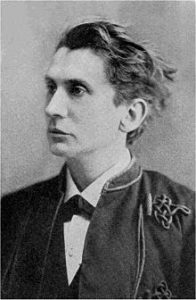 |
| Leopold von Sacher-Masoch (1836-1905?) Austrian uuthor of Venus in Furs. |
Nowadays, if you have ever heard of the Austrian man of letters and novelist Leopold von Sacher-Masoch, you know that he wrote the scandalous novella Venus in Fur(s) (1870), which in 2011 became a hit Broadway play by David Ives and was made into a movie by the notorious and highly kinky auteur Roman Polanski in 2012. In 2012, Nina Arianda won the Tony for Best Actress in the lead role of Vanda Jordan. In 2014 it was the most performed title across the US in repertory theaters. Dead for over 100 years, von Sacher-Masoch has been enjoying a bit of a comeback.
 |
| Nina Arianda and Hugh Dancy in the 2011-12 Broadway production of David Ives’ Venus in Fur. |
If you know two things, you know that Richard von-Krafft-Ebing decided to name his clinical diagnosis—masochism–for sexual arousal to pain and humiliation, after Sacher-Masoch. This has given Leopold a good deal more than his standard allotment of 15 minutes of fame, and made ‘masochism’ a dirty word for over 130 years, and led to considerable fuzzy thinking about what exactly we are dealing with when we encounter kinkery that involves pain and submission.
 |
| A depiction of Baba-Yaga’s hut. Consultations with the crone are not for the faint of heart. If you don’t know your slavic folk tales, you probably know Baba-Yaga’s hut from the game Dungeons and Dragons! It first appeared in the Eldritch Wizardry expansion back in 1974. |
You probably don’t know that Sacher-Masoch was a prominent professor and writer of Slavic folktales which are in and of themselves a repository for plenty of dark themes. Think Baba-Yaga, the mysterious but capricious and powerful crone who could help or hinder the innocent. Or witches that cooked greedy little children in ovens. Or Little Red Riding Hood saved only when she was cut from the wolf’s stomach after getting eaten. Pretty Grimm stuff! Sacher-Masoch anthologized folktales from German, Jewish, Slavic and Polish traditions before writing two novels. Only Venus in Furs was translated into English. Any examination of his collected works reveals that von Sacher-Masoch was obsessed with tyrannical punishing women and he seems to have scoured central European mythologies for examples. Suffice it to say, such tales were there to be found, and that Sacher-Masoch passionately needed to tell them!
This post is about von Sacher-Masoch’s contributions to kink. Another post will follow shortly discussing his psychiatric symptoms in more detail. Although he never intended to lead anyone, and fought having his name used, he has had a strong influence on people who practice kink, and on those who study it.
Young Leopold was born in Lemburg, Austria Hungary, now Lviv in the western Ukraine, in 1836. He grew up in time to be greatly affected the second industrial revolution and the formation of a powerful German State. A Catholic born son of an Austria-Hungarian civil servant and a mother who was the last heir of the noble von Sacher family, Leopold was the first to be born with the hyphenated Sacher-Masoch name. Despite noble blood, Leopold was sympathetic with socialist and feminist thinking of his day. He was ardently opposed to antisemitism and wrote compelling stories of Jewish life in his region. It is likely that the young Leopold grew up in a household with conflicts attending recent accession to the nobility. It is pure speculation on my part that his mother’s nobility may have upset the prevailing patriarchal dynamics in young Sacher-Masoch’s household and may have had a role in his interest in powerful women. But his mother was not a powerful and punishing figure as so often appears in his literature. His father was no slouch, having been Chief of Police in Lemburg, Prauge, and Graz, all parts of the Austria-Hungarian Empire at the time. His father acquired the title of knight, which passed to Leopold later in life when his father died.
He was educated in Graz, Austria, where he was an excellent student; his passion was the study of folktales and history quickly overtook his original training in law, which he never practiced. He soon returned to Lemberg and became a professor of history, but tired of academic lecturing and he returned to Graz to devote all of his time to writing. He then began publishing his ambitious collection of stories, The Legacy of Cain, in 1869 of which Venus in Furs is the only work routinely translated into English. He would eventually complete one other volume, The Mother of God. But outside of Slavic languages and literature scholarship, Sacher-Masoch’s legacy lies entirely within his contributions to kink and clinical theory. This legacy comes from three sources. First is from his novel, which came to be seen as autobiographical, the second is through Richard von Krafft-Ebing’s Psychopatha Sexualis, and the third is from his first wife’s memoirs.
Venus in Furs
 |
| Venus in Furs (1870) The lovely Gustav Klimt illustration was added later. |
The novel was begun sometime in the mid 1860’s and completed in 1869. It is set as a tale within a tale, as one man attempts a kind of kink reparative psychotherapy on another who, following a meditation on Titian’s painting Venus with a Mirror, falls into a dream of speaking to the goddess and develops a mania for subjecting himself to the mercies of a cruel women. The main plot of this cautionary story concerns protagonist Severin von Kusiemski, who, as a child discovers that he is a ‘suprasensualist’, and as an adolescent is severely whipped by his aunt, a noblewoman who habitually wears furs, and is deliberately intent on punishing him so brutally that he learns the pleasures of being beaten. He indeed finds himself overwhelmed with sensuous feelings associated with the punishment and craves to repeat it. As a grown man, Severin falls in love with a woman, Wanda von Donajew, who becomes his mistress. Severin ardently desires to become Wanda’s slave and for her to wear furs and beat him. He broaches the idea of becoming submissive to her, and she is initially resistant, but agrees to try it out, only to progressively recognize the advantages. Severin proposes and Wanda draws up a legal contract for him to become her abject slave, and in a textbook example of seduced consent, she terrorizes him about the potential harshness of the arrangement. She rejects the submission of traditional marriage for the empowerment in Severin’s proposed contract. Confronted with the apotheosis of all his fantasies, he tremblingly signs his life away… literally, as late in the novella, he contracts to suicide in accordance with his plans to have Wanda sexually betray him with another man.
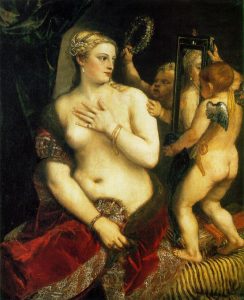 |
| Titian’s (1588-1676) Venus with a Mirror, which mesmerizes von Sacher-Masoch’s protagonist in Venus in Furs. |
They then travel to Florence where they can pursue their contract away from their respective social circles. Per the contract, Severin takes the name ‘Gregor’, that of a common servant, and travels third class while Wanda rides in luxury. In Florence he wears the livery of a servant, and adheres to the contract, serving her in all ways, as she grows progressively crueler and her love and fascination transform into contempt. Eventually Wanda exploits the full measure of her power over Severin, and ties him up, and leaves him for a real man, a handsome Greek who will dominate her. Rather than whip him as he ardently desires, she has the beautiful new paramour perform the beating. She has come to despise Severin for his weakness even as she enjoyed dominating him. The climax of the novel is this beating and Wanda’s departure. The contracted suicide is merely implied. This tragic outcome should thus serve as warning to the framing story’s protagonist of the perils of sexual submission of the male. For despite all niceties to the contrary, women must either be men’s despots or their slaves, and men who crave submission court their own destruction.
Venus in Furs, which would seem to be an exciting story about love of dominant women is in fact set up as a warning about female weakness and their inevitably abandoning ways, and similar themes in his other stories have provoked many critics to regard Sacher-Masoch’s work as misogynist. In his writing on contemporary and historical matters, Sacher-Masoch was a feminist, socialist, and advocate for women’s suffrage. In his fiction, women come off as vain, craven, selfish, and ultimately weak. As much as he craves submission to them, he regards himself as morally superior, a peculiar and problematical position from which to submit.
Psychopathia Sexualis
 |
| Psychopathia Sexualis (1886) The John Willie illustration was added later. Krafft-Ebbing would never have approved. He wrote much of his book in Latin for fear of corrupting lay readers. Bondage illustrator and Bizarre Magazine (1946-56) publisher John Coutts had no such compunctions. |
When Psychopathia Sexualis was first published in 1886, Venus in Furs had been in print for 16 years and had had an impact not unlike the 50 Shades series in 2011. It was published in a society in which reading novels was a very common form of entertainment. It brought von Sacher-Masoch a great deal of notoriety precisely because it stood out against the prevailing ideologies of the times. Industrializing central Europe was being pulled in nationalist, socialist, ethnocentric and liberalizing directions. The Austro-Hungarian Empire was losing its grip on restive minorities, women were pressing for social equality, and science was challenging religious traditions of Catholicism and Protestantism alike. Venus in Furs did not spark the wave of sexual experimentalism that 50 Shades has, but this is the era in which vibrators were first used to relieve women’s sexual tensions, Psychoanalysis was used to treat an epidemic of hysterical conversion reactions, and sexual hypocrisy was a widespread response to Victorian moralism. Spencer’s social Darwinism was gaining wide credence, and warfare was thought to be manly pursuit that would strengthen a country by short decisive wars that established national superiority. Austria’s bid to unite the German states had been crushed in 1866 by the Prussians in the Austro-Hungarian War. In 1870-71, the North German Confederation formed around Prussia after its victory over Austria decisively defeated France, resulting in the unification of Modern Germany. These events seemed an obvious validation of Spencer and Darwin.
 |
| Herbert Spencer (1820-1903) British Philosopher and leading proponent of Social Darwinism, although he was closer to a Lamarkian. Still, scratch a Neocon today, and you find a modern veneer over Social Darwinism. |
This was the context in which the Belle Époqueemerged and in which Venus in Furs, Psychopathia Sexualis, and Freudian psychoanalysis became crucial symbols. Readers who recall the previous post on Richard Krafft-Ebing will have little trouble recognizing that the details of Venus in Furs play directly into the Viennese psychiatrist’s theories that aberrant sexual desires reflect degenerative impulses contrary to evolution’s reproductive purposes. Severin fails to impregnate Wanda, fails to cement his relationship with her, and is eventually abandoned for a reproductively fit male. In fact, Sacher-Masoch’s tale hints at Severin’s sexual attraction to this fine male specimen, and that is precisely in line with von Krafft-Ebing’s theories on sexual inversion (homosexuality). That the story also exploits conventional ideas of class only serves to underscore the doctor’s point about sexual superiority of normophilic sex. It seems entirely natural that Krafft-Ebing, given his theoretical perspective and the prevailing cultural context, would name his paraesthenia for desire for sexual pain and humiliation ‘masochism’.
When von Sacher-Masoch learned he had been made the poster boy and namesake of the sexual perversion for arousal from sexualized pain, a contentious correspondence ensued. von Sacher-Masoch feared identification with the diagnosis would damage his credibility as a writer. But Krafft-Ebing seized the professional high ground, claiming that the novelist could have no objection to the use of a neutral medical term that implied no moral taint and was a simple scientific description. We might be more inclined today toward empathy with Sacher-Masoch’s point, but as Psychopathia Sexualis became the dominant psychiatric work in the paraphilia discourse and the Freudians picked up the term masochism, Sacher-Masoch’s attempts to get out from underneath the label were fruitless.
In his 50’s Sacher-Masoch’s mental health severely deteriorated and he was placed in an asylum. There is some dispute about when he died, but he stopped writing and was in no condition to defend himself. Although this correspondence with Krafft-Ebing clearly began before Sacher-Masoch became ill, I do not know how, if at all, this dispute may have affected his condition.
“Confessions”
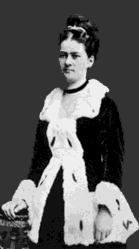 |
| Aurora von Rumelin, Sacher-Masoch’s first wife and author of Confessions, as Leopold would have preferred her, limned with furs. |
Much of what we ‘know’ about Leopold Sacher-Masoch’s personal life is provocative, but comes primarily from the memoirs that are attributed to his first wife, Aurora von Rumelin. A certain professional skepticism would seem to be justified by this tale, which came to light after his death, and in the context of the considerable social stigma attending his name being lent to the disorder. Conditions of the sales and marketing of this story also exploit the salacious quality of the material. The original version of Meine Lebensbeicht was published in German in 1906, and in French the following year as Confession de Ma Vie under the name Wanda von Donajew, Severin’s fictional paramour. It was then published in English in 1991 by RE/search and Rip Off Press in 1991 under the title Confessions of Wanda Sacher-Masoch. Despite the ‘von’ as evidence of her nobility, Aurora was not from a noble family, and then there is the opprobrium attendant her partnering with Leopold and his scandalous behaviors to contend with. So critical readers of Confessions have been at pains to deconstruct her point of view.
In these memoirs, Leopold is described as fascinated by history form an early age. The turbulent times of central Europe and deeply affected him, he was given to creating puppet shows inspired by a bloody peasants revolt in Poland in 1846, and the Revolution of 1848 that swept much of Europe. his father, as chief of Police was posted to Prague during these chaotic times, had an active hand in supressing the revolution, and brought home stories. But even asa pre-adolescent, Leopold was drawn to creating and recalling narratives in which he is atthe mercy of cruel female rulers. After Prague, his father was posted to the quiet town of Graz where Leopold became a stand out student. He entered the University of Graz and had earned his law degree by age 19. He lectured there in history, and later moved to Lemberg as a professor. It wass during this period he began formally publishing tales of rural and ethnic life.
Within the Romanticism current in his day, von Sacher-Masoch’s tales were well received. Although later critics would comment on his tendency to dwell on certain themes that were the core of his obsessions, his accounts were by and large sympathetic, nuanced and vivid. Only occasionally did his work descend into melodrama. He wrote sympathetically of ethnicities and nationalities that were not always accepting of one another. When not emotionally unsettled by conflict or upset by his obsessions, he made a decent living as a writer. His stability was much marred by by a general impulsivity with money, and his obsession with furs was expensive. He wound up moving frequently. He was easily manipulated and went through his money quickly when he had any.
Leopold’s first sexual affair was with Anna von Kottewitz a beautiful woman 10 years his senior who was fine with his desire to be beaten, but gradually became disenchanted when his demands for whipping and for betrayal with another lover became excessive. She seems to have mainly been drawn to the aristocratic lifestyle and notoriety that came from romancing a successful author. Leopold was very productive during this relationship, writing in an attempt to keep her in the style she preferred. Their relationship eventually collapsed after she grew tired of his efforts to get him to betray him with another man. After several years one of these characters proved to have a criminal history and gave her syphilis, which was then incurable so the prolonged affair had to be ended in some embarrassment.
Leopold then had a brief affair with a French actress. Mademoiselle Clairemont she bore him one daughter, Lina. While he enjoyed their relationship and she was reputedly very beautiful, he was dissatisfied with her lack of aristocratic bearing and refinement he really craved, and their relationship collapsed after less than one year.
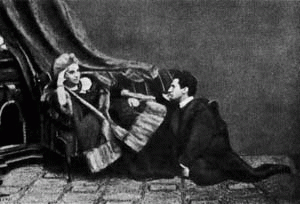 |
| Fanny Pistor and Leopold share a quiet moment. |
In 1869 and by then a writer of some reputation, von Sacher-Masoch met Fanny Pistor who sought his help with her own writing career. They quickly turned their attentions to matters romantic, and he arranged the following sadomasochistic contract with her just like the one that Severin agreed to with Wanda von Donajew:
“Her Leopold von Sacher-Masoch gives his word of honor to Frau Pistor to become her slave and to comply unreservedly for a period of six months with every one of her desires and commands.
For her part, Frau Pistor is not to extract from him the performance of any action contrary to honor, i.e. which would dishonor him as a man or as a citizen. She is also to allow him to devote six hours a day to his professional work and agrees never to read either his correspondence or his literary compositions.
The Mistress (Fanny Pistor) has the right to punish her Salve (Leopold von Sacher-Masoch) in any way she thinks fit for all errors, carelessness or crimes of Lèse-majesté on his part.
In short, her subject, Gregor, must accord his mistress a wholly servile obedience and accept as an exquisite condescension any favorable treatment she extend to him. He recognizes that he has no claim upon her love and he renounces all rights whatsoever to a lover’s privileges.
Fanny Pistor, on her side, promises to wear furs as often as possible, especially when she is in a cruel mood.
This period of servitude is to be considered at an end after six months and no serious allusion to it will be permitted at the expiration of the period.
Everything that may have happened must be forgotten. The original love-relationship will then be resumed.
This six months need not run continuously. They may be interrupted for long periods, which will begin and end whenever the Mistress chooses. this pact is hereby put into force by the signatures of the contracting parties.”
He signs this on Dec 9, 1869, shortly before the publishing of Venus in Furs. It is clear that significant portions of Venus in Furs are strongly autobiographical. He travels third class, assumes the name “Gregor”, and wears the livery of her servant, just as Severin does in the novel. Following an exciting period in Italy, Frau Pistor and Von Sacher-Masoch decline to renew the contract after rather less than the full six months and go there seperate ways.
The success of that novel led to a number of young women who wrote anonymously to von Sacher-Masoch about the titillating themes of the book. In (1873) Aurora von Rumelin, after a prolonged exchange of provocative letters, met Leopold under a streetlamp in Graz, heavily veiled and under the pretense of recovering compromising missives sent by a friend, and Leopold is seduced into striking up a relationship. In their first meeting alone, she beat him with a whip and he agreed shortly thereafter to a private wedding in which he wore a white coat and tails and she was dressed in furs. This wedding was later followed by a public wedding as befit his noble station, but Aurora and Leopold could not consolidate a stable marriage and their years together were not happy. Aurora especially disliked Leopold’s mania for arranging sexual betrayals for her with men. and despite frequent pregnancies, the couple had three children together and two painful losses, Leopold was obsessive, did not stay satisfied for long, and they were not sexually happy despite his enjoyment of beatings. For her part, Aurora who had ardently desired the aristocratic life, was never satisfied with the reality she was able to achieve with Leopold. In 1879, following the death of his adored older son, he divorced Aurora for his assistant Hilda Meister. Hilda struggled with Leopold’s declining mental health, and in the late 1880’s he was hospitalized in an asylum. He was officially declared dead in 1895, but is alleged to have lived on in the asylum for another decade. Actually, his death remains somewhat murky.
As described by von Rumelin, Leopold was not a man to stay satisfied, and even had she not been terrified that his moody instability would leave the family penniless, she was dominated by her husband’s social and professional status and could never fully trust his demands that she betray him with other men given the prevailing divorce laws of the period. Much of her account in Confessions emphasizes his agency over hers. Although she went to elaborate lengths to seduce him, given his writings, it would be hard for any reader to doubt that he was the driving force for kink in their relationship. He pursued it with a rigidity that was tiring to all of his partners. And Leopold might have originated the idea of ‘topping from the bottom.’ As hard as it might be for a highly educated and titled aristocrat to permanently surrender power to his less educated female partner in the later half of the 19th century, he didn’t seem to accept the fate he had bargained for very well.
von Sacher-Masoch’s legacy for kink:
Aside from lending his name to the diagnosis of masochism and the sex practice itself, von Masoch can also be seen as the source of the idea of contracting, and laying the foundations for consent in modern BDSM. In publicizing his enthusiasms, he also inspired the kink practice of cuckolding, and he started a complicated conversation about the relationship between power and control in masochism, a problem that is still very lively in kink’s discussions today.
Contracting and Consent:
For von Sacher-Masoch, who cared very much what he said and wrote, and who had trained in law, the contract is crucial to the reality of sexual submission. He used this strategy with Fanny and Aurora and others. Unlike de Sade, who in writing and in deed inflicted his sexuality without boundaries, consent established the boundaries of his submission, even if ultimately he badgered his way around them. Although consent did not become a discourse in kink until 1982, von Sacher-Masoch left contracting as a legacy 100 years before there were above-ground kink organizations.:
Power and Control:
The appropriation of contracts did not solve all problems, however. In Venus in Furs, later readers are greatly troubled by implications of the conflict between dominance and control in this contract. While the idea for the contract is Severin’s, and the actual contract proposed is Wanda’s, agreed to with only a little negotiation with Severin, Severin’s ultimate goal in signing the contract is to get Wanda to give up control of her freedom to leave him. Yet when he loses his free agency to worship her and his objectification by contract renders his desire for her irrelevant, she is no longer constrained by her desire to be freely worshiped, loses her desire for him, and eventual, she leaves. Ultimately, she would rather surrender to her desire than be constrained by the contract. Von Sacher-Masoch writes, and his later critics deconstruct, this contract as if the inherent asymmetries in male and female biology, and as embodied in the sexual inequality of male and female social roles, are inevitable and the contract is doomed to failure. The von Sacher-Masoch’s chronic marital unhappiness does little to undermine this impression.
 |
| Economic slavery, to which consent is irrelevant. |
Historically, people have not held slaves because their masters desire them, but because slave holders desire their labor. On occasion, masters have fallen in love with slaves, and even more frequently, the labor of slaves has included responsibility for sexually servicing their owners. But Wanda desires control over Severin’s worship and adoration, which slave owners do not ordinarily care about or value. Neither did slaves often have to fear abandonment as long as their labor was useful. The definition of slavery in the masochistic contract really hinges on the vulnerabilities lovers feel in the face of their own desires. von Sacher-Masoch’s life history would seem to show that masochism shows little prospect for permanently overcoming that ambivalence. As desirous of being a slave as he might have been, his marriage to von Rumelin was dominating of her. Coitus and parenting provided him little reassurance and did not provide ultimate stability for his fear of abandonment. The contract to be her slave could not overcome the social context in which he as a male and aristocrat was dominant over her as a commoner and a woman. Eventually, Leopold left Aurora.
 |
| Matt Groening’s depiction of ambivalence. If Freud had drawn Homer Simpson, instinct would have occupied one shoulder and social rules would occupy the other, instead of angels and devils |
Freud would go on to make great capital of the ambivalence while ignoring the power dynamics. The struggle between moral ideas of the super ego and the lusts of the id was essentially ambivalent. His neurotics were slaves not to desire, but to their inability to recognize the inevitable conflicts and accept their ambivalent nature, egged on as they were by excessive social repression. von Sacher-Masoch’s relationship history is fertile ground for Freud’s explanations, the writer is repeatedly unable to consolidate a stable and satisfying love life no matter how his partners attempt to comply.
 |
Emmanuel Sevigny and Mathieu Amalric in Roman Polanski’s version of David Ives’ Venus in Fur (2012).
Roman Polanski made diabolical films even before the tragic Tate/La Bianca killings in 1969 and his prosecution for sex with an 13 year old and flight from the US in 1977. Sevigny is now his wife. In this version, Sevigny;s character is an actual goddess. |
It might be argued that Venus in Furs is only role play, and the David Ives’s play would seem to highlight exactly this aspect. Vanda Jordan comes in late out of the rain eager to play the part of Wanda von Donajew. But the power in that play highlights a crucial insight about von Sacher-Masoch’s desire, that the slavery contract render his new status anything but a social role that might under mundane circumstances be discarded and return him to power. In the play, Vanda stops auditioning for a role and becomes a goddess with the power to dominate, and to abandon, that no bargain can overcome. The feminist objection to Venus in Furs to von Sacher-Masoch is overcome with magical realism, in fact, the argument that Wanda might not really have the power in their relationship is precisely mentioned by Vanda in the play! Ives and Polanski insist that she does.
But modern kink has come to recognize that the desire for submission and dominance is a kind of figure/ ground illusion. The political requirements of consent, stemming as they do from inherent democratic equality, mean that even in 24/7 sexual slavery, Master and slave begin negotiation from a position of equivalent agency. Take way physical freedom, safewords, the opportunity to own property or phone home, the slave still agrees to the role of slavery, and ultimately must come up for air, if only to renew the contract. For in actual slavery, no contract is needed, and the slave has no power, no personhood, and no essential value whatsoever, only the value of service. This is pure utilitarianism, the opposite of lust a point on whch von Sacher-Masoch and De Sade, his apparent opposite number, would agree. Real slave owners took the control of the slave as proof of their own agency, but could not further elevate themselves relative to an audience of their peers by exercising rights already assumed. Sadism was already privileged. It was mundane, not exoctic; utilitarian, not romantic. de Sade would have been most disapproving of the strategy of trying to solve this problem with any sort of contract!
Female Dominance:
Venus in Furs is not only the founding document of masochism and the origin of the sadomasochistic contract and the problem of consent, but it is a founding document of female dominance. In a Western social context of rising female equality, its timing and placement are significant. For all of von Sacher-Masoch’s liberalism, the idea that females are too vain and weak to be dominant without destroying their partners seems shockingly retrograde. Venus in Furs is not an endorsement of genuine female empowerment. This is true even in Polanski’s modern revision, in which the fumbling aspiring actress Vanda Jordan ultimately becomes terrifyingly powerful personification of cruel female divinity. No true equality seems possible, only a game in which dominance is played at, and powerful men temporarily surrender their power for a little recreation with the gracious assurance they will still control their tech start ups at Monday morning executive committee meeting. Vanda must be a terrifying goddess incarnate, or fall back into the desperate audition for an acting role before a powerful director.
Modern criticisms of this retrograde depiction of female dominance abound. But there is still great transgressive power in the feverish excitement Wanda and Severin enjoy as they fail their negotiation. The novella shows that lust can dwell in female empowerment, even if Goethe and Kant and Spencer have warned the right relation with women is subservient, Richard von Krafft-Ebing was eager to ratify it, and Freud would go on to describe women’s sexual satisfaction as inherently masochistic. His error was his lack of empathy to imagine that penetration might be anything other than painful.
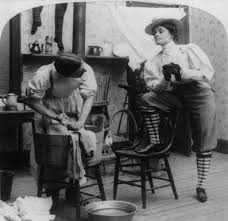 |
| Anti-suffragette propaganda was already presenting themes of female domination outside of the bordello. |
I would argue that Krafft-Ebing had no chance of recognizing masochism as a perversion had he not found its doctrine articulated by a man, and that not only women’s subservience but women’s desire for subservience was so normalized in the context of the Belle Époque that only a man’s endorsement of masochism could be regarded as deviant and thus as proof of pathology. After all, men needed to submit to men all the time in an aristocratic society. But men need never submit to women. Neither should we be surprised that the existence of female kinky desires awaited the doctrines of female liberalization and psychologizing of the 1960s and 70s. There are as many kinky women in BDSM social organizations today as males, but for sexology’s first 100 years following Krafft-Ebing, only men were thought to be kinky.
 |
| Late 1800’s Lesbian sadomasochistic erotica. Sacher-Masoch was far from the only artist presenting these themes in European culture. |
In fact, professional domination became the reigning metaphor throughout the period after Venus in Furs for men who were excited to enact their submissive kinks. Certainly it was there in the discourse about women’s suffrage. It is highly likely, given the role of prostitution, the changing roles of women, and the reactive religious moralism that accompanies those changes that the role of dominatirx would had to have been invented if von Sacher-Masoch hadn’t articulated it. In fact, it has existed in bordello culture for perhaps a couple hundred years before it became popularized by changes in gender role expression. But efforts to declare prostitutes or dominatircies as proof of female kinks foundered on the grounds of pragmatism. If kinks were really crazy expressions of sex desire that were contrary to reproductive success, prostitution was constructive, albeit amoral economic behavior. Those opposing prostitution urged criminalization to raise its costs as a rational economic strategy, and decried the exploitation of women by claiming the morally degraded status of the role of prostitutes victimized women far more than any earnings could compensate. In this climate, the idea that a woman could be truly dominant as a sex worker eluded social recognition for over a century, and remains very much in social dispute today. The idea that sexual domination might be an expression of a woman’s sexual desire, rather than a submission to male desire, is still widely under recognized. This denial is remarkable in the face of a steady string of exposes by prostitutes in which they honestly described their reasons for being in the life, and despite the Freudian recognition that people chose their social roles, including their occupations for over-determined and unconscious reasons. But these arguments went unrecognized and were discounted because they conflicted with conventional discourse on gender roles.
 |
| Photography meant consumer’s that did not dare enter a bordello could partake of themes that were explored there. “Photography is the new drug.org!” |
Cuckolding and Key Holding:
Likewise, Venus in Furs is a foundation document in cuckolding and key holding. Van Sacher-Masoch does not dwell on coitus, orgasm control or on the agonies and pleasures of sexual withholding, which are at the core of this modern kink. But Severin’s readiness to give up coitus, and von Rumelin’s complaints about her sex life with Von Sacher-Masoch have suggested to later readers that masochism is desexualized. This would only be tangentially challenged by Freud when he argued that feminine masochism was at the core of biologically driven female desire. This mistake, as well as laws against prostitution may have led to mistaken ideas that masochism is not about sex, only about pain and submission. Reading the historical record as closely as I can, Sacher-Masoch, although weakened as a writer by excessive fixations on his obsessions, was not a good example of Krafft-Ebing’s degenerative and desexualized masochist. Coitus remained an important part of his sexual expression throughout, and he fathered at least 6 children with his various partners, including one with a French actress before Fanny Pistor, three with Aurora von Remelin, and 2 Hilda.
But Freud was correct that Sacher-Masoch’s work was not dyadic. Wanda beats Severin, but arranges for black servants to participate, and in the climax of the story, has her Greek lover perform the ultimate beating. Venus in Furs is a triangular story, both in its relation to the framing story, and in Severin and Wanda enacting their relationship in relation to others, be it the law, servants, the audience that perceives his social abasement as a servant in third class during their travel on the train, or in the need to flee to Venice to evade their social circle.
This is also the essential structure of cuckolding play, that thrives upon not only the power of orgasm control, but in the enactment of the preference of the key holder for a “bull’, who is submissive to her desire to inflict humiliation on the cuckold both by seeing her enjoy her sexual release with a more masculine man, but also her domination of the bull in penetration of the feminized cuckold.
Coda:
 |
| Leopold von Sacher-Masoch’s statue in Lviv is a great opportunity for photo ops! Oh, a collar! How convenient! |
Back in Lviv, Leopold von Sacher-Masoch remains a local boy who made good. His folktales are a robust validation of Ukrainian identity in region of dangerous political fluidity. They play down the ambiguous ending of his life in madness. There is a statue commemorating the author, and a restaurant, the Masoch Café, done up in dungeon accoutrements. For those with retrograde conventional tendencies, they boast the best fondue in town. For those who prefer cuisine a l’outrance, try the bull’s testicles and menu with sadomasochistic illustrations. For an aperitif, the female wait staff provides free whippings. Perhaps this would be a good time and place to consider your requests and tipping strategy carefully.
 |
| Red and black, er, dominate the decor of Cafe Masoch in Lviv. |
Part II of this essay on Leopold von Sacher-Masoch will include the imapct of his case on psychiatry, and references for these essays.
© Russell J Stambaugh, May, 2016, Ann Arbor MI, All rights reserved

















